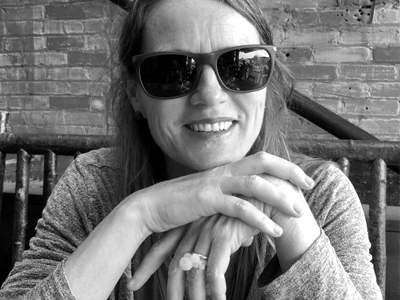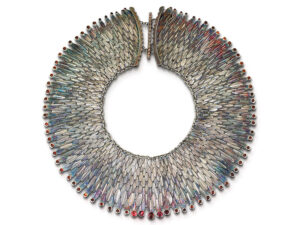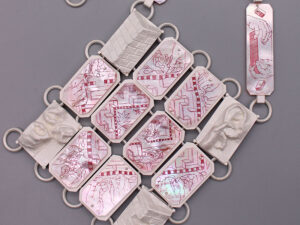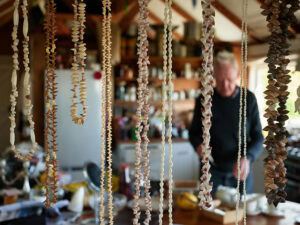
Karin Seufert is a German artist who received her training in the Netherlands and currently lives in Berlin. Her work has been featured in numerous exhibitions worldwide and has also included curatorial projects and lectures around the globe. She has made innovative use of PVC in her work for a number of years. In this interview, she discusses the conceptual basis for a new twist in its application, for which she was selected as a finalist for the Susan Beech Mid-Career Artist Grant.
Katja Toporski: First of all, congratulations on being a finalist for the Susan Beech Mid-Career Artist Grant! You wrote such an interesting proposal—well-deserving of this recognition!
Let me begin by asking you a little about your background. You’re originally from Germany. Please tell us how you arrived at jewelry as a field, and which path you took for your training.
Karin Seufert: Thank you so much! I’m very glad you’re my interviewer, not only because I like the interview you did with Cristina Filipe but also because, since we share German as our first language, you’ll understand my language/mistakes and perhaps my thoughts.
I started my training in the Netherlands in 1985 at a school in Schoonhoven called MTS Vakschool, where I got my education in gold- and silversmithing. It was quite traditional, and during my practical year in Amsterdam I could feel that working like that would not be satisfying for the rest of my life. I applied to Rietveld Academie, not really knowing what lay ahead of me, and studied with Professor Ruudt Peters for the next five years.
It was an important time, and my best contacts are from this period. I discovered a completely new world of jewelry, as would happen for a lot of people when they first come in contact with contemporary jewelry. All happened in that time. I learned to broaden my view of jewelry, to reflect on my work and to develop it.

How did your career evolve after you completed your education as a jeweler?
Karin Seufert: Three years after graduating from Rietveld Academie, I moved back to Germany, to Berlin, where I still live. I decided to find breadwinning work to perform alongside my own jewelry in order to be independent with what I’m doing.
The first year I worked as a restorer on the big sculpture of Frederick the Great, which is now relocated in Unter den Linden. After that I started to work for Niessing (a German jewelry manufacturer) in their first store in Berlin.
Needless to mention that most of my time is reserved for my own work.
In Amsterdam I had a studio together with a friend; here in Berlin, I decided to work at home. A large part of my time goes into developing and working on my jewelry and finally exhibiting the results. Aside from that, I’ve curated an exhibition together with a colleague, which included the realization of the accompanying catalog, acquiring funding, installing the exhibition in different galleries all over the world, and lecturing about it. FWQNWS (First We Quake Now We Shake) was the title of this exhibition. At the moment I curate, together with two colleagues, an exhibition of our group, KGB (København, Göteborg, Berlin). I gave several workshops in different countries, I was teaching, worked as a tutor and examiner, and had a couple of trainees here in my studio. Above all I like to travel, especially in combination with my work, e.g., to give lectures or to exhibit my work. More recently, writing about jewelry started to get my interest.

For your project you propose to conduct an investigation into emptiness and the form of the void, using the spaces created by the architecture of Zaha Hadid as a starting point. You write about obtaining a “core” void form from your personal experience of this architecture. Please tell us more about the process you want to employ in order to obtain those void forms.
Karin Seufert: My idea was to visit several of her buildings to get my own impression of being inside of them. The outside tempts you, opens your fantasy, while the inside gives an experience to your whole body, like the way that when you enter a cave, a sense of fear as well as protection can surround you. I wanted to see what happened when I’m inside these buildings. Do they exceed the expectation the outside offers?
Now for the moment I have to limit my experience by looking at books about her architecture, mainly showing the buildings from the outside. I chose the architecture of Zaha Hadid because there’s something unexpected in it. The buildings are curvaceous like grown creatures/sculptures, surprisingly fitting with their neighborhood while being something else completely. I use part of these shapes and rebuild them in paper. Not exactly, but based on what I expect to see. More and more models develop like that; I have to make a lot of different samples before I decide about the right proportion and an interesting shape. It starts to become a paper city here in my studio!
The next step is to reproduce the paper sample in the core material, upon which I can fix the final PVC dots. This is a solid material that I have to carve, rasp, and grind to achieve a shape similar to the paper one.
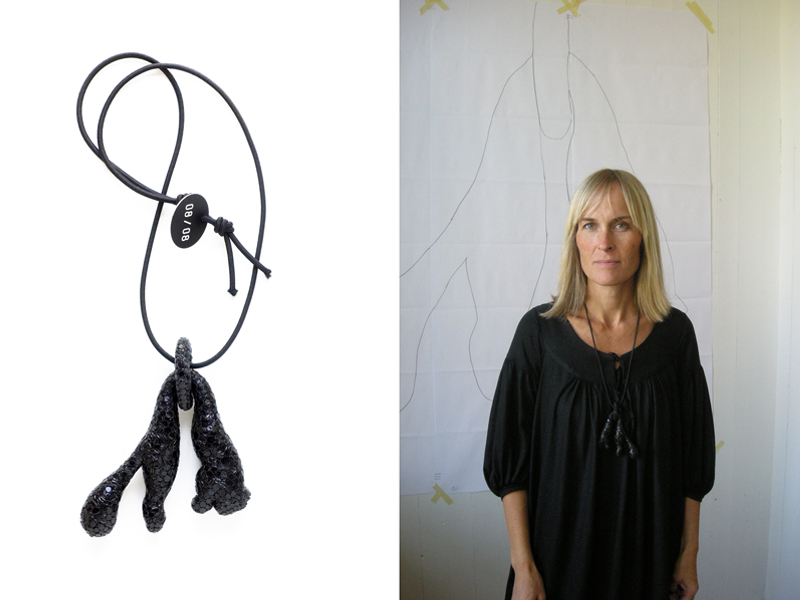
You describe an intriguing concept of an original form that gives form to something else, like a master copy, which gets destroyed as part of the process. Is this an approach you have also taken in your previous work?
Karin Seufert: The practical part of how to do this I discovered earlier. It was when I considered the massive structure inside the jewels as not suitable anymore and discovered how to get a stable hollow shape. It sounds like a paradox, but I started the development of my stone series from this discovery: I shaped a stone in the core material, covered it with PVC dots, and because of the little opening it became necessary to destroy the original shape to finally arrive at the stone made as a light shell consisting only of dots.
In this new work, the construction of the core is involved consciously in my process. The shape is designed in paper first. Angles and sharp edges are part of the new shapes, as is the emptiness inside which achieves a new importance. It forces me to work more precisely, and while considering how it will look in the end, I have to try to keep this new angularity in the shapes. The core doesn’t always have to be destroyed, depending on the opening, but it’s destroyed anyway during the process because of all the needles penetrating it. The inside and the outside are of the same importance and depend on each other.
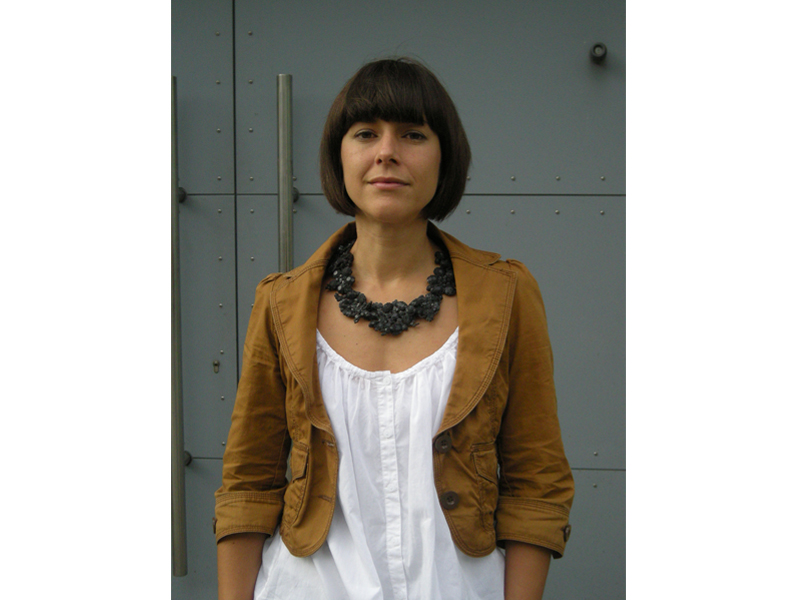
What do you see as the relationship between architecture and jewelry? Clearly both are expressions of three-dimensional form with specific functional constraints. How does our experience of large spaces translate into our perception of jewelry?
Karin Seufert: Both architecture and jewelry are inevitable, but in different ways. The function of architecture is to give us shelter against the weather, to comfort us, to let us feel protected and safe, to relax us, to let us come together, etc.
Jewelry includes the same function, but on a different scale. It’s a kind of shelter as well, not against rain and snow and sun, but for yourself or for the reason of beautifying yourself, to tell something about yourself, to underline your personality, to show your membership, your situation and relation toward others. It’s like taking a part of your home with you, and since we aren’t snails, we can’t take our house with us; instead we have our jewelry to reflect what’s important to us.

In your proposal, you describe your interest in the relationship of the outside to the inside of a building. Do you think that relationship is similar in a piece of jewelry, or are there differences you’d like to emphasize?
Karin Seufert: The difference is included in the perception. The possibility of entering a building lets you experience it wider. My expectation by seeing the outside and then entering a building mostly differs. When entering a building you are surrounded completely, all your senses are involved. The sound and the reflection of it, the scale and your size in proportion to it, the smell, the dampness or dryness of the air, the light entering and changing, etc. All your senses are active, you’re encircled, included, you’re inside.
The distance and/or the inclusion of your body make the difference.
In a jewel you see the outside and, with some exceptions such as with a locket, when the inside is the important part, there isn’t really a question about an inside. Of course there are exceptions to this, but still, your perception remains limited, you’re outside.
Within my series of voids, I’ll use inside and outside in parallel. One of my ideas is that the removed core makes space for the void. The appearing emptiness is the void, and the shell encloses this void. Other thoughts are to show the shape of emptiness as a volume or only the lines marking that space, or focus on the atmosphere of a space, etc.
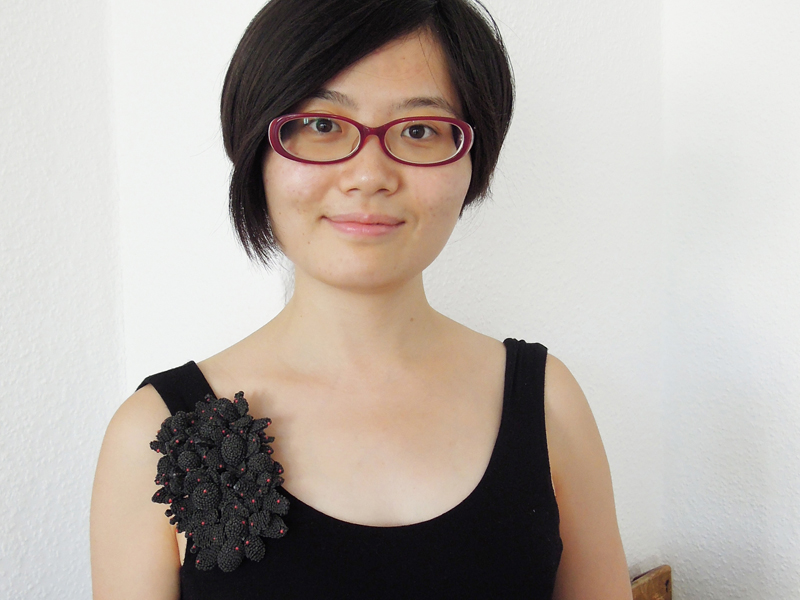
You mention as your inspiration the manipulated interior spaces by Gregor Schneider in his Haus u r project, and the concrete castings of interior spaces by Rachel Whiteread. Do you commonly cross over into the fine art world, and where do you see differences and/or similarities with the contemporary art jewelry world?
Karin Seufert: I was fascinated by the concrete castings by Rachel Whiteread, how she managed to make the invisible visible and solid. The way she shows the absence. I love this idea; it’s a wonderful thought concerning my voids, to focus on the void itself as a shape, a massive object.
An atmosphere of constriction and anxiety through the manipulated perception of the surrounding is inherent in Haus u r, by Gregor Schneider. The characteristic atmosphere of a space could be another approach, e.g., as in a reflection of that experience.
I’ve seen another example of inside/outside in an exhibition in Berlin in a work by Anish Kapoor titled Memory. I could see inside the object from different angles but it was impossible to imagine how the shape of the outside could be. It’s an opposite approach to get a grip of a shape while you aren’t able to view it in its entirety.
There are a lot of examples from the art world that inspire me and there are also examples from the contemporary art jewelry field (I’ll describe several of them later) that add and give an input to my work. It’s one world. The question is, how intense and convincing the results are.

The search for the void has been ongoing in contemporary art for a number of decades. Please describe the development of your own interest in this.
Karin Seufert: My interest in voids started with several experiences. At Documenta 9, I had to wait for hours in the burning sun until I could finally enter the little white concrete building. A guard was standing in front of a black circle placed like a carpet on the ground and I was disappointed and confused until, slowly, while getting used to the little light inside the room, I started to realize the space under that circle. A big hollow round space completely covered with black color/pigments. Descent into Limbo was a work by Anish Kapoor, where you had the feeling of getting roped into the inside.
The other time was during a visit of the Jewish museum in Berlin (by Daniel Libeskind), when it had just opened. I remember very well the spaces, which were clearly marked as “Void.” They emanated an emptiness, which was so endless and so sad, an exceptional experience. It was the moment I started to think about the void, and not that long ago I started to give space to it in my work.

Following on from the previous question: Do you see that this has been a theme in contemporary jewelry, too, and where does your own work fit into this theme within the jewelry frame?
Karin Seufert: Space and void has been always a theme in jewelry, since the body is the stage and there is a space around it that could include jewelry. The scale varies, as can be seen in the work of Pierre Degen from the beginning of the 80s, where you step into or even carry the work, rather than wear it. The borders are blurred in his work between jewelry, art, and performance.
On a slightly smaller scale is the work Schönheitsgalerien, a series of photographs by Otto Künzli from 1984 in which women wear imitations of gilded historical frames. It’s about posing and portraits, about beauty and about space and void. It refers to art because of the frames, while it shows the relation between body and object in the moment of wearing, the moment the frame-void is filled by a person.
A more recent work, and smaller than the two just described, comprises the color-box brooches by Tore Svensson from 2010. The void space here is inside the box and it’s covered with color. One can consider these brooches as vehicles for transporting diverse feelings through color. Here the void is not entered, like it is with the first two examples, but the body is the screen on which it’s shown.
I can’t frame my work yet since it’s in progress. There are different aspects attracting me; perhaps after a while I’ll see more clearly where I come out.

You describe your process of building up shells around a form using PVC. Could you tell us more about how you started developing this process, and in what way it differs from what you’ll do for this project?
Karin Seufert: I got addicted to PVC and the dots many years ago when I was searching for a good material to make a bag for another piece of jewelry. I had to place a hook in this bag, and before I could do that I had to punch out a circle. I got a perfectly round dot, and the first piece I made with PVC was a chain consisting of only dots arranged on a thread.
I still use this connection with the thread, but I’ve added glue as well, and when I put two layers of dots above each other, I can remove the core afterward and get a stable shell. For my Void project I try to find different structures on the outer layer. The second layer is the one I experiment on for the time being. The outcome is partly determined by the material that comes on the market, as constantly changing colors, thicknesses, and surfaces become available. The shells get thinner and I work with the transparency of the PVC and the mixture of colors next to the surface structure. The dots are not only standing or lying, they will also be arranged like fish scales, for example.

On the back of being a finalist for the mid-career artist grant, what are your plans for the future with this project?
Karin Seufert: Even though I’m not the winner, I’m very happy to get this chance to talk about my project on your platform. Thank you!
I’ve hardly started, I mean I have, but it feels that until now I have only tipped the top of the iceberg and the deeper I dive, the more paths open up, as it is when you start working with something. If you’re asking me what I’ll do … I’ll for sure continue with it.
Next year I’ll have two exhibitions: one at Ellen Reiben’s gallery, Jewelers’werk, in Washington, in June, and the other in November at Gallery Marzee, in Nijmegen. In both places I’ll show the results I have to that point, but since this kind of work is quite time-intensive, I see these exhibitions only as starting points or mid-object points.
Perhaps I’ll manage to acquire funding to travel to some of the buildings by Zaha Hadid and visit them inside. I would love to do this since I’m convinced that it would add something to my perception and finally to my work. Another perspective/wish is to make a book about my work.
Is there anything you have read recently that inspired you? Do you have any recommendations for AJF’s audience?
Karin Seufert: A little while ago I read an article about the Australian artist Fiona Hall. She presented her work at the Venice Biennial 2015 with the title Wrong Way Time. It was a kind of “Wunderkammer” and looked extremely captivating. I felt attracted to the way she works with the material. I could feel similarities to my own way of working, even if our materials are completely opposite and the results are as well. Her objects bear a certain likeness to jewelry, matched with a love for detail.
Thank you!
***
カリン・ソーファー
2017年スーザン・ビーチ・ミッドキャリア助成金給付コンペファイナリスト
執筆:カチャ・トポロスキー
カリン・ソーファーは、オランダで学び、現在はベルリンに住むアーティストだ。その作品は国を問わず数多の展覧会やキュレーション・プロジェクト、レクチャーで紹介されてきた。彼女は長年、PVCを斬新な手法で加工して作品にしてきた。そして、その発展形ともいえるプロジェクトで、スーザン・ビーチ・ミッドキャリア助成金給付コンペのファイナリストに選出された。このインタビューではそのコンセプトを聞いた。
カチャ・トポロスキー:まずは、スーザン・ビーチ・ミッドキャリア助成金給付コンペのファイナリスト選出、おめでとうございます! 最終選考に残るにふさわしいたいへん興味深い企画でした。
まずは経歴を少しお尋ねします。あなたはドイツ出身とのことですが、ジュエリーという分野にたどり着いた経緯と、どのような教育を受けたのかをお話いただけますか?
カリン・ソーファー:ありがとうございます! カチャさんにお話を聞いていただけて、とてもうれしいです。クリスティーナ・フェリペへのインタビュー記事もすばらしかったですし、母国語が私と同じドイツ語なので、話し方のくせや間違いをわかってくださるだろうし、私の考えもくみとっていただけるのではないかと思って。
私は、1985年からオランダのスコーンホーフェンにあるMTS Vackschoolという学校で宝飾と金工を学び始めました。伝統を重視する傾向があまりに強く、アムステルダムで1年間の実習訓練を受けた時に、一生この仕事を続けても満足できないだろうと悟りました。それで、将来のことは深く考えずにリートフェルト・アカデミーを受験して、ルット・ペータース教授のもとで5年間学びました。
この5年間はとても重要な時期で、当時出会った人たちは今でもたいせつな友人です。コンテンポラリージュエリーをはじめて知った人の多くが同じように感じると思いますが、まるで新しいジュエリーの世界を発見できた気がしました。すべてが集約されていた期間です。ジュエリー観を広げ、自分の作品を振り返り、発展させる術を学びました。
ジュエリーの制作技術を学んだ後は、どのようにキャリアを積みましたか?
カリン・ソーファー:リートフェルト・アカデミーを卒業して3年後にドイツに帰国してベルリンに引っ越し、今もそこに住んでいます。帰国後は、ジュエリー以外にも生活を支えるための仕事を見つけ、ゆくゆくは、今私がやっているような仕事だけで独立しようと決意しました。
最初の1年は修復家として働き、現在はベルリンの大通りであるウンター・デン・リンデンに移転されたフリードリヒ2世の銅像の修復を手がけました。その後、Niessing(ドイツのジュエリーメーカー)のベルリン第一号店に勤めました。
言うまでもなく、当時は自由な時間のほとんどを制作に充てていました。
アムステルダムでは友人とスタジオを共有していましたが、ベルリンでは自宅が作業場も兼ねています。ほとんどの時間を作品の構想や制作に費やし、最後にその成果を展示します。過去には、同業者の仲間と展覧会のキュレーションをしたこともありますよ。その時は、カタログの製作や資金の調達、各国の巡回先のギャラリーでの設営作業、レクチャーもやりました。FWQNWS (First We Quake Now We Shake)という展覧会です。現在は、2人の仲間と一緒に、KGB(コペンハーゲン、ヨーテボリ、ベルリンの頭文字)というグループ展のキュレーションを行っています。複数の国でワークショップを行ったこともありますし、教員や審査官を務めたり、今のスタジオで研修生を何人か育てたりもしました。なかでも、レクチャーや展示などの仕事の予定を旅行に盛り込むのが何より好きです。最近ではジュエリーについて文章を書くことにも興味があります。
今回の企画は、ザハ・ハディドの建築物の空間を出発点に、空洞とその造形表現を考えるというもので、あなた自身がこの建物を訪れた経験をもとに「核」を成す空間の造形を創り出すという内容です。どのようなプロセスでそれを達成していくのか、聞かせていただけますか?
カリン・ソーファー:私の案は、ザハ・ハディドの建築を実際にいくつか訪れて、中に入ったときの感覚を味わうというものです。建物の外観は、人を惹きつけ想像力をかき立てます。いっぽうで内部に足を踏み入れる行為は全身で感じる体験で、洞窟の中にいる時のように、守られている感覚と恐怖感とに同時に襲われます。私は、ザハ・ハディドの建築の中に入るとどんな感じがするのか知りたいと思いました。外観を見て抱く予想を上回るものなのだろうか、と。
現時点では情報源がかぎられていて、彼女が設計した建造物の外観が主に紹介されている本を見るよりほかありません。ザハ・ハディドを選んだのは、彼女の建築にはどこか思いがけない要素があるからです。彼女の建築は、成長した生き物や彫刻作品のような曲線美が特長で、強烈な異彩を放ちながらも、驚くほど近隣になじむという特質をかねそなえています。私は、これらの造形の一部を紙で再構築します。実物をそっくりそのまま再現するのではなく、こう見えるだろうという予測をもとに作業を進めます。これだと思えるプロポーションやおもしろい造形が出てくるまで、サンプルを大量に作らないといけないので、どんどん模型がふえてしまい、最近ではスタジオが紙の模型でできた町のようです。
その次は、紙のサンプルを核となる素材で作り直し、その上に丸くくりぬいたPVCを貼りつける作業が待っています。核にする素材は、削ったりやすりをかけたり磨いたりして紙の模型に近づけていく必要があるので、硬い素材を使います。
いまお話していただいたコンセプトは、なにか別のものを生み出すために、原本ともいえる元の形を作業の過程で壊すという点が興味深いです。過去にも同じ手法で作品を制作したのでしょうか?
カリン・ソーファー:この方法は以前に思いついたものです。ジュエリーの内部をみっちりした塊で作るのはしっくりこないと思うようになった時期があり、空洞でも形が崩れない方法を考え出しました。この構造には無理があるように聞こえるかもしれませんが、この方法を発見できたからこそ石のシリーズを作り始めることができたんです。このシリーズでは、核にする素材で石を作り、それを丸くくりぬいたPVCで覆いました。その時に中の石を壊せるように小さく隙間を残しておき、くりぬいたPVCだけで構成される、殻状の軽い石が最後に残るようにしました。
今回の新作では、核を構築する作業を意識的に制作工程に盛り込むようにしました。まず紙で形をデザインします。これらの新しい造形は角ばらせてエッジをシャープに仕上げ、中を空洞にするのが新たな重要なポイントです。これによって精度の高い仕事が求められ、最終的な見え方を考えながら、新しい要素である角ばった造形を維持するよう注意しなければなりません。開口部の残し方によっては必ずしも中身を壊さなくてもよいのですが、中の針が外まで貫通しているので結局は壊します。外側も内側も同じぐらい重要で、相互に依存しています。
建築とジュエリーの関係についてはどうお考えですか? どちらも立体的な造形表現で、機能上の具体的な制約があります。広い空間で体験する感覚をジュエリーの次元に置き換えるにはどうすればいいと思いますか?
カリン・ソーファー:建築もジュエリーも、あり方は違えど人間に必要なものです。建築物の役目は、シェルターとなって気候から身を守ってくれることです。また、快適さや、守られているという安心感を与え、リラックスできて人々が集う場所を提供してくれます。
ジュエリーも同じような役割を担いますが、スケールが違います。シェルター的な役目も果たしますが、雨や雪や日差しから身を守るのとは違って、自分を美化することで自分を守ったり、自分自身の何かを伝えたり、個性を強調したり、何かの会員の証にしたり、自分が置かれている状況や他者との関係を示したりするのがジュエリーの仕事です。家の一部を持ち運ぶようなものです。人はかたつむりと違って家を背負って歩けないので、家の代わりにジュエリーをつけて、自分にとって何が大事かを表明するのです。
企画書によれば、あなたは建物の外観と内部の空間の関係に興味があるとのことでした。ジュエリーにおいても似たような関係が見られると思いますか? それとも両者の差異を強調したいとお考えですか?
カリン・ソーファー:両者の違いは感じ方にあります。建造物は、中に入れることでより多彩な体験ができます。外から見て内部をあれこれ想像しても、中に入るとたいてい期待を裏切られます。建物の中に入ると完全に包囲され全感覚が総動員され、音やその反響、建物との比率から感じるスケールや自分の大きさ、空気の湿り気や乾き、外からの光やその変化などが飛び込んできます。全感覚が活性化し、建物に取りかこまれ、その一部となり内部に取り込まれます。
この距離や、自分の体が建物の一部と化す感覚は、ジュエリーとは異なる点です。
ジュエリーの場合、中身が重視されるロケットなどの一部の例外を除いては、外観に着目するものであって、中身はあまり重視されません。もちろん例外があるとはいえ、認識は限定的で、見る人は外側の存在です。
制作中の空洞をテーマにしたシリーズでは、中身と外側を並行して扱っています。私の考えのひとつは、核を取り除くことで空洞のための空間ができるということ。こうして出現した空洞は空虚で、外側の殻がこの空虚を囲っています。ほかには、空洞の造形を立体やその空間を定義する線のみで表現したり、ひとつの空間の空気感を集中して見せたりすることを考えています。
あなたが挙げるインスピレーション源には、グレゴール・シュナイダーが「ハウスウーア」プロジェクトで示した操作された内部空間や、レイチェル・ホワイトリードによるコンクリート鋳造の室内空間がありますが、ファインアートの世界を参照することはよくありますか? また、ファインアートの世界とアートジュエリーの世界との相違や類似点は何だと思われますか?
カリン・ソーファー:レイチェル・ホワイトリードのコンクリートの鋳造作品は、見えないものを固体にして可視化するという「不在」の見せ方に惹かれました。名案ですよね。空間を造形として着目し、塊のオブジェで表現するという発想が見事で、私の空洞のシリーズにも通じるものがあります。
グレゴール・シュナイダーの「ハウスウーア」には、環境の感じ方を操作することで表現される収縮や不安の感覚が示されています。その時の体験から思い起こされるような、ある空間が持つ独特の空気感を見せるというのも、また別のアプローチかもしれませんね。
ベルリンのある展覧会では、アニッシュ・カプーアの「メモリー」を見ました。この作品は内部と外部が表現されていた例でした。さまざまな角度から内部を見ることができるのに、外側がどんな形か想像がつかないというオブジェ作品です。全体像が見えないまま形を把握するというのは、対極的なアプローチです。
アートの世界からインスピレーションを受けた例は多くありますし、コンテンポラリーアートジュエリーの分野からも作品づくりのヒントをもらっています(後ほど例示します)。アートジュエリーもひとつの世界ですよね。完成品がいかに力強く、説得力があるかどうかがポイントです。
空間というテーマは、現代美術界で何十年も追及されてきましたが、ご自身はどのようにして空間に興味を持つようになったのでしょうか?
カリン・ソーファー:いくつかの体験がきっかけで空間に興味を持つようになりました。そのひとつは、ドクメンタ9を訪れた際のことで、白いコンクリートの建物の前で灼熱の中を何時間も待たされた挙句、やっと中に通されたら、地面にカーペット状に敷かれた黒い円の前に守衛が立っているだけということがありました。これには落胆も困惑もしましたが、ほとんど光の射さないその部屋にだんだん目が慣れてくると、その円が空間であることに気づきました。大きな円形の空間が黒い塗料で塗りつぶされていたのです。これはアニッシュ・カプーアの「リンボへの降下」という作品で、穴の中に吸い込まれそうな感覚に陥りました。
開館してまもないころに、ダニエル・リベスキンド設計のベルリン・ユダヤ美術館を訪れたことも空間を意識するようになったきっかけです。「空虚」が際立つ空間で、とてもよく覚えています。はてしなく悲しい虚無感が発せられていて、特異な体験でした。この頃から空間について考えるようになり、最近では自分の作品にも空間を取り入れるようになりました。
先ほどの質問の続きです。空間や空洞というテーマは、コンテンポラリージュエリー界でも扱われてきたと思われますか? また、ご自身の作品は、ジュエリーという枠組みにおける空間の表現において、どういう位置づけにあると思われますか?
カリン・ソーファー:空間や空洞というテーマは、ジュエリーでも常々扱われてきました。身体はステージで、ジュエリーはその周囲の空間に取り込まれるわけですからね。そのスケールはさまざまで、80年代初頭のピエール・デーゲンの作品は、身に着けるというより中に入って作品を運ぶという、ジュエリーとアート、パフォーマンスの境界を曖昧化した作品でした。
もう少し小さい作品でいえば、オットー・クンツリが1984年から制作しはじめた「美女ギャラリー」があります。古いめっき加工された額縁の模造品を首にかけた女性を映した写真作品です。見せかけや肖像画、美、空間、空しさがテーマにされています。額縁の使用によってアートにも言及しており、着用時、つまり額縁の空間が人によって埋められている瞬間における身体とオブジェの関係を示しています。
もっと最近の作品で、いまお話ししたふたつの作品よりもさらに小さなもので言えば、トーレ・スベンソンが2010年から制作を始めたカラーボックスのブローチがあります。箱形をしていて、中はからっぽで色が塗られています。このブローチは、さまざまな感情を色に託して持ち運ぶための手段であるとも考えられます。ここでは、さきほどのふたつの作品とは違って、人が空間に介在することはありませんが、身体を背景に空間が表現されるという点は同じですね。
いまの作品は制作している最中なので位置づけは説明できません。いまはまだいろんな要素に興味が湧いている段階なので、もう少し時間がたてば、どういうふうになるのかはっきりしてくると思います。
PVCを使ってひとつの形の周囲に殻を構築するという工程のお話がありましたが、どんなことがきっかけでこの方法を思いついたのでしょうか? また今回のプロジェクトではこの方法にどんな変化を加えようとお考えですか?
カリン・ソーファー:何年も前に、ジュエリーを入れる袋を作るのにちょうどいい素材を探していたことがあって、その時にPVCに出会い、この素材の虜になってしまいました。この袋にはフックを固定するための穴を開ける必要があり、パンチで抜いたらきれいな真円ができたのです。そこで丸形だけを紐に沿わせて並べてチェーンを作ったものが、PVC作品の第一号となりました。
今でも紐を使っていますが、接着剤も使うので、2枚の丸を重ねると、後から中の核を取り除いても殻状の形を維持できます。空洞のプロジェクトでは、外側にくる構造を変えてみようと思いました。この第二の層を目下実験しているのです。市場に出回る製品は、色や厚み、表面の加工が日々変わるので、その時に手に入る素材で出来栄えが左右されます。私は殻を薄くして、PVCの透け感や、色の取り合わせと表面の構造の組み合わせを考えます。くり抜いた丸は、立てたり寝かせたりするだけでなく、例えば魚のウロコ状に配置することもできます。
ミッドキャリア給付金コンペのファイナリストに選ばれた結果を踏まえ、今後はどのようにこのプロジェクトを発展させていきたいですか?
カリン・ソーファー:結果的に給付金を逃してしまったとはいえ、この場を借りて私のプロジェクトについてお話させていただけるのはたいへんうれしく、感謝しています。
このプロジェクトは始まったばかりで、今のところは氷山の一角に着手したにすぎません。新しいことを始めたときの常として、深く掘り進むほどにさらに多くの道が開けていく感じがします。今後の展望については、この先も間違いなく継続していくだろう、ということぐらいしか言えません。
来年にはふたつの展覧会が控えています。ひとつはエレン・ライベンが経営するワシントンのギャラリー、Jewelers’Werk Galerieを会場に6月に行われるもの。もうひとつは、ナイメーヘンのGallery Marzeeで11月で行われるものです。いずれの展覧会も、その時点での成果を見せるつもりですが、この手の作品はかなりの長期戦になるものなので、出発点や途中経過を公開することになるのではないかと考えています。
もし旅費を調達できれば、ザハ・ハディドが設計した建築をいくつか実際に訪れ、中に入ることができるかもしれません。私としてはぜひそうしたいところです。自分の意識、ひいては作品にもプラスの作用があるはずですからね。もうひとつの展望や希望としては、自分の作品集を作ることです。
最近読んだものでインスピレーションを受けたものはありますか? AJF読者へのおすすめがあれば教えてください。
カリン・ソーファー:少し前にオーストラリア人アーティスト、フィオナ・ホールに関する記事を読みました。彼女は2015年のベネチア・ビエンナーレに「Wrong Way Time(誤って進む時間)」という作品を出品したそうです。この作品は一種の「驚異の部屋」的な空間で、人を引き込む力がありました。また、作者の素材の扱い方にも惹かれました。使う素材も作風も正反対なのに、私の手法に近いものが感じられたので。彼女が作るオブジェにはどこかジュエリー的な雰囲気があって、それがディテールへのこだわりと調和していました。
ありがとうございました!
カチャ・トポロスキー:ドイツ、フランクフルト生まれ、ワシントンD.C.郊外在住。ジュエリー作家、教授、ライター。哲学的思考を特長とした作品を制作し、原形的な物体や要素を並置することで、人間の物体に対する理解の限界を探っている。アメリカ国内外での数多の展覧会に出品し、紙媒体やウェブ媒体への作品掲載も多い。最近では「metalsmith」誌が主催する2016年度の誌上展覧会に出品。あらゆる分野の本を読み、ジュエリーについて文章を書き、そこから得たテーマを作品で探求している。
